#fantômas (1913)
Text

I’ve been watching some Louis Feuillade (<- French director, known mostly for his 1910s pulp crime films)
#louis feuillade#Les vampires 1915#fantômas 1913#fantômas#judex 1916#judex#my art#all of these have been fun! I do think Édouard Mathé should have played fandor in fantômas#doodled this because I’ve been having trouble finding fanart of my fav weird old films. be the change you want to see etc etc
53 notes
·
View notes
Text

Fantômas (as Loupart) and his accomplice, Josephine.
René Navarre and Yvette Andréyor in Fantômas II: Fantômas contre Juve (1913)
#rené navarre#yvette andréyor#fantômas (1913)#fantômas#louis feuillade#1910s#classic film#silent film#french cinema#serials#imagestill#my post
56 notes
·
View notes
Text
THIS DAY IN GAY HISTORY
based on: The White Crane Institute's 'Gay Wisdom', Gay Birthdays, Gay For Today, Famous GLBT, glbt-Gay Encylopedia, Today in Gay History, Wikipedia, and more … December 11

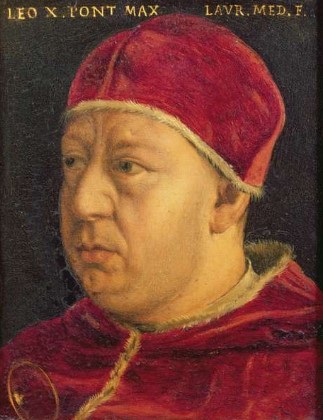
1475 – Pope Leo X (d.1521), born Giovanni di Lorenzo de' Medici, was the Pope from 1513 to his death in 1521. He was the last non-priest (only a deacon) to be elected Pope. He is known for granting indulgences for those who donated to reconstruct St. Peter's Basilica and his challenging of Martin Luther's 95 Theses. He was the second son of Lorenzo de' Medici, the most famous ruler of the Florentine Republic, and Clarice Orsini. His cousin, Giulio di Giuliano de' Medici, would later succeed him as Pope Clement VII (1523-34).
Several modern historians have concluded that Leo was homosexual. Contemporary tracts and accounts such as that of Francesco Guicciardini have been found to allude to active same-sex relations - alleging Count Ludovico Rangone and Galeotto Malatesta were among his lovers.
Cesare Falconi has examined in particular Leo's infatuation with the Venetian noble Marcantonio Flaminio, with Leo arranging the best education that could be offered for the time. Von Pastor has argued, however, against the credibility of these testimonies, and rejected accusations of immorality as anti-papal polemic. Gucciardini was not resident at the papal court during Leo's pontificate, while other contemporaries such as Matteo Herculano took pains to praise his chastity. Paul Strathern, a British writer and academic, argues that Leo, while homosexual, was not sexually active as pope, despite identifying notable members of that family as such.

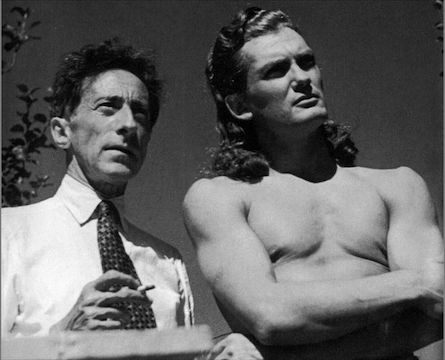
Jean Cocteau and Jean Marais
1913 – Jean Marais, French actor (d.1998); Marais was never much of an actor, and it is doubtful he would have achieved international fame had he not become Jean Cocteau's lover, but he was, by universal acclaim, one of the most handsome men ever to appear in films. In the 1940s when he made most of his movies for Cocteau, actors were still slicking down their hair with Kreml and Vitalis. But he changed all that. His cheveaux fous and athletic good looks created a new style of postwar leading man.

When in 1946 he spent his time in Cocteau's Beauty and the Beast, trapped within an ape-like constume, waiting for Beauty's kiss to turn him once again into Jean Marais, Gay moviegoers around the world secretly wished that they were Josette Day who actually got to kiss the handsome actor's furry face. What is perhaps most interesting about the friendship between Cocteau and Marais is that the actor's face in profile bore an astonishing resemblance to the boys Cocteau had been sketching for thirty years before meeting him.
In the 1960s, he played the famed villain of the Fantômas trilogy. After 1970, Marais's on-screen performances became few and far between, as he preferred concentrating on his stage work. He kept performing on stage until his eighties, also working as a sculptor. In 1985, he was the head of the jury at the 35th Berlin International Film Festival.


1948 – Alvin Baltrop (d.2004) was a gay African-American photographer who earned fame through his photographs of the Hudson River piers during the 1970s and 1980s.
Baltrop was born in 1948 in the Bronx. He discovered his love of photography in junior high school. Baltrop received no formal art education; older photographers from the neighborhood taught him different techniques and how to develop photos himself.
Baltrop enlisted in the Navy as a medic during the Vietnam War and continued taking photos, mainly of his friends in sexually provocative poses. He built his own developing lab in the sick bay, using medic trays for developing trays. After his time in the Navy, Baltrop worked odd jobs as a street vendor, a jewelry designer, a printer, and a cab driver. Because he wanted to spend more time taking photos at the Hudson River piers, he quit his job as a cab driver to become a self-employed mover. He would park his van at the piers for days at a time, living out of his van to take pictures.
From 1975 through 1986, Baltrop took photographs of the West Side piers, where he was a well-known member of the community. Baltrop knew every person he photographed, and people often volunteered to be photographed. Younger boys and men at the piers often confided in him about their sexual orientation, their relationships with their families, their housing status, and their work.
Baltrop captured the gay cruising spots and hookup culture that existed in New York City before the AIDS epidemic. Baltrop's photographs not only captured human personalities, but also the aesthetics of the dilapidated piers. His life work is a snapshot of gay, African-American, and New York City history.
Baltrop struggled to make his way in the art world, facing racism from the white gay art world. Gay curators often rejected his work, accused him of stealing it, or stole his work themselves.

"Three Sailors"
Late during the 1990s, NYC artist John Drury, who knew Alvin from their shared neighborhood - Drury living on Third Street, with his wife and Baltrop on Second Street, in lower Manhattan - befriended the artist and recognized the photographers unique abilities, nominating him for a Louis Comfort Tiffany Foundation Award for the Arts. Alvin Baltrop had few exhibits in his lifetime; his work gaining international fame only after his death.
According to one journalist, Baltrop came out as gay at fourteen years old. Baltrop had long term relationships with men and women, but preferred identifying as gay.
Baltrop was diagnosed with cancer in the 1990s. Impoverished and without health insurance, curators and filmmakers attempted to exploit him for their own financial gain. He died on February 1, 2004


1990 – Nakshatra Bagwe, born in Mumbai, India, is an Indian actor and award winning film maker. Nakshatra will be making his Indian feature film debut in My Son is Gay and is due for his international film debut as the lead actor of Hearts. His films Logging Out, Book of Love, Curtains and PR (Public Relations) represent the current LGBT scenario of India.
He is a LGBT rights activist and also an organiser of Gujarat's first ever pride march. Nakshatra has participated in several Pride Parades in India. He won KASHISH – Mumbai International Queer Film Festival in 2012 for his debut film Logging Out. It was screened at prestigious venues like Queens Museum of Arts (New York), The Old Cinema (London) and it was also a part of Queer India European tour 2012 to raise awareness about LGBT issues in the Indian context.
Nakshatra hails from Konkan coastal region. Masure, Malvan is his native village. He takes part in homosexuality awareness projects. Nakshatra and his mother were featured in a promo of popular Indian television show Satyamev Jayte. He came out to society when he participated in Asia’s first LGBT flashmob. He also participated in second queer flashmob which happened at Dadar station, Mumbai. Nakshatra posed nude for a campaign named 'Breaking Closets'.
In July 2014, He became the brand ambassador of Moovz, a global social network for gay men. Nakshatra is first and only openly Indian LGBT person to be signed up as the brand ambassador by any brand till now.

1998 – The mother of Tyra Hunter (1970 – 1995) is awarded $2.9 million in a wrongful death lawsuit against the city of Washington DC. Hunter, a pre-operative transsexual, died of injuries sustained in a car accident in 1995. Emergency medical technicians at the scene were abusive and withheld treatment, and a doctor at DC General Hospital failed to follow nationally accepted standards of care.


18 notes
·
View notes
Text
While we’re on this topic of old films we watched and enjoyed, some random movie recs from the 1910s through to the 1970s based on the things that popped into my head fastest. Warning in advance, I like horror, noir, swashbucklers, dark comedy and dodgy fantasy films.
1910s
Fantômas serials (1913/1914) – As I said in the previous post, if you ever get a random hankering for silent-era pulpy French crime thrillers, these are an excellent start.
1920s
Metropolis (1927) – the imagery in this movie is absolutely stunning, even if the morals are extremely heavy-handed. Worth it for the Robot Maria transformation sequence alone. Also, and I feel mean for thinking this, because the poor man’s going through hell, but there are moments where Freder is truly hilarious. And also, Batman: The Animated Series owes so much, visually, to this movie. It single-handedly shape a vision of what cities and the future and architecture and transport could look like.
Nosferatu (1922) – imagery. The Germans were so fucking good at imagery in early cinema. Admittedly the movie does some very strange things to the Dracula mythos, and is probably the source of a lot of later ideas of him that have nothing to do with the novel (the sunlight thing), but it’s so cool.
1930s
M (1931) – Peter Lorre is incredible. And actually the whole set up of this movie is so creepy and tense and enthralling, and then the court scene busts it wide open. Deals with some heavy things, including child murder, vigilante justice and mental illness, but it’s so good. And you will never hear ‘Hall of the Mountain King’ the same way again.
The Thin Man (1934) and sequels – they’re half hardboiled noir and half screwball comedy, but they’re not a parody, because they predate most of the noir genre, so this is more of a funny hybrid precursor series. And they’re really funny. If you just want some pep and jazz in your life, a good time for an hour or so, totally watch these, they’re adorable.
The Prisoner of Zenda (1937) – Okay. I just like a good swashbuckler? You will see Zenda several times on this list, because I enjoy a lot of versions of this, but of all of them you need to start with this one, because Douglas Fairbanks Jnr. No one else will ever do Rupert of Hentzau like him. If you like your charming, snarky villains, if you like your Lokis, Rupert of Hentzau. Douglas Fairbanks Jnr. If you also like your villain and your hero to have powerful sexual tension and lean very close to each other while crossing blades, again. Rupert of Hentzau. Just watch. You’ll see.
Son of Frankenstein (1939) – I’m not going to lie, I watched this movie purely to see where Young Frankenstein (1974, also very much worth a look) was getting a lot of its in-jokes and gags from (Inspector Kemp in YF is riffing off Inspector Krogh in this movie). But it is worth watching wholly on its own merits. Among other things, Inspector Krogh is a genuinely cool and compelling character (as a kid, the monster ripped his arm out during its first rampage, and during this movie Krogh fully stands up to that childhood nightmare and has a cool moment with his prosthetic arm), and if you have any interest in Basil Rathbone, Boris Karloff or Bela Lugosi, this movie is fantastic. Lugosi in particular as Igor does so much in this movie. If all you picture when you think of him is Dracula, try this. (And The Black Cat (1934), which also has Karloff and Lugosi, but is significantly more intense).
1940s
The Mark of Zorro (1940) – Okay. I like swashbucklers. I like movie sword fights. This movie has the best movie sword fight ever. Basil Rathbone vs Tyrone Power. No contest. And, I mean, yes, the rest of the movie is also good. But watch it for the sword fight. Perfection.
The Wolf Man (1941) – This movie and Casablanca between them gave me a bit of a thing for Claude Rains. I don’t know, he’s just really compelling to watch. Very soft-spoken, but very there. And if you want the tragedy of the werewolf curse, this is the movie that started it all. This is not a monster movie. This is a psychological horror story of one man breaking apart under the burden of a curse. It’s so good.
Casablanca (1942) – I mean, it’s everyone’s answer. It’s stereotypical, the classic movie. But it is very, very good. Extremely quotable. I wish to punch Rick in the face several times over. And Claude Rains as Renault is so sleazy, but also so compelling.
Arsenic & Old Lace (1944) – If you ever wondered what the deal with Cary Grant was. This movie. His face. The whole movie just rides on his face. His reactions, his body language. I mean, the movie does a lot of things spectacularly. If you enjoy dark comedy, this is the pinnacle. Hiding bodies in window seats, kill count competitions between a psychotic criminal and his maiden aunts, the extremely morbid running gags of ‘yellow fever’ and Teddy charging up the stairs and the elderberry wine. But really it’s all Cary Grant and his fucking expressions. There are several points in this movie where I can’t breathe. For a man with so many suave, serious leading roles, his physical comedy was incredible.
The Big Sleep (1946) – This was the movie that introduced me to noir. Not the Maltese Falcon, not Double Indemnity, not Sunset Boulevard. This one. The Big Sleep. And you can argue that it’s not the best of the noirs, it’s a bit too caught up in itself, the plot if you pay attention has some big holes in it, and if you compare it to the book one female character in particular got rather cheated. But. As an introduction. It does land, very definitely. Bumpy Go-Cart (sorry, Humphrey Bogart) and Lauren Bacall are all that and then some. If you want to pick a noir, you can do a lot worse.
1950s
The Prisoner of Zenda (1952) – Mostly I like this as a compare/contrast to the 1937 one. It’s damn near a shot-for-shot remake, and while that could be a bad thing, it’s fascinating what differences and interpretations show up because of that. Watch the ’37 one first, and then watch this one. It’s just cool to compare them. And, you know. It’s still a really fun swashbuckler.
The Court Jester (1955) – Just the best time. The best. I have an unreasonable amount of fondness for this film, this gentle send-up of previous swashbucklers and period dramas in the vein of The Adventures of Robin Hood, and basically every movie Basil Rathbone ever made. Watch it for Danny Kaye, watch it for the tongue twisters, watch it for a baby Angela Lansbury, watch it for an absolutely hysterical duel scene, watch it for Maid Jean being the single most competent character there. Just watch it. I cannot entertain criticism on this point. It’s excellent, and I’m not sane about it.
Some Like It Hot (1959) – Jack Lemon is going to show up again later in this list, and for good reason, (as is Tony Curtis, but we don’t care as much about him), but Some Like It Hot is also, for a 1959 movie, a really gentle, funny, interesting look at gender roles? I mean, the premise is two dudes going undercover as female musicians with an all-female band to avoid mob hitman, and one of them keeps getting hit on by rich man while the other struggles to get it on with Marilyn Monroe in his male persona while trying to hide from mob assassins in a female persona, so it could be such a hot mess, but it actually … It’s quite gentle. Marilyn’s Sugar gets to talk about what men expect when they see her and, because he’s pretending to be a woman, Tony Curtis’ Joe has to listen to her, Jack Lemmon’s Jerry/Daphne gets to get genuinely swept up in the feeling of being romanced as a woman to the point that he’s semi-seriously talking about marriage, and in the end, when Jerry reveals he’s a man to Osgood, the rich old idiot who’s been trying to romance ‘Daphne’, Osgood famously just goes ‘well, nobody’s perfect’, and still appears perfectly willing to marry ‘her’. I mean, it has its issues still, but there’s such a lot of gentleness in it for a comedy movie made in 1959.
1960s
The Innocents (1961) – One of my two all-time favourite horror movies, on raw atmosphere alone. It’s so eerie. SO EERIE. It’s horrible and twisted and goes heavy places (child death, a child acting ambiguously sexually while possibly possessed, strong questions of sanity), but it’s done so gracefully and gently and eerily. If Gothic Horror is of interest to you as a genre, if you enjoyed Crimson Peak, try this. It is all beautiful sunshine and sprawling lawns and twisted desires and paranoid terrors and the single eeriest scene I’ve ever seen in anything ever. Watch the lake scene. It’s stunning.
The Raven (1963) – Pivoting back to comedy horror, this time with added fantasy. Vincent Price has been in a lot of better movies, but I’m not sure if he’s been in many funnier ones. Him and Peter Lorre just own this movie. Wall to wall ham. Just. Just go in, just watch it. There’s a loose frame plot of duelling magicians, vague references to Poe’s ‘The Raven’, Boris Karloff returning as a villain, animal transformations, and the obligatory young romance getting embroiled in their sorcerous parents’ plots (although, jarringly, the young romantic lead is a baby Jack Nicholson, which sure gives it a weird vibe), but honestly? You’re here for Vincent Price and Peter Lorre and the wizard duel.
The Great Race (1965) – Jack Lemmon is back, as is Tony Curtis, but we only care about the former of those, because Professor Fate (obligatory shouting). Okay. I don’t know how many people remember the old Hanna-Barbera Wacky Races cartoons? Am I aging myself here? But this is the movie they were based on, and Professor Fate is who Dick Dastardly was based on. The premise is a 1910s global car race between Curtis’ Great Leslie (you will want to punch him, and that’s perfectly natural) and Lemmon’s Professor Fate, an exaggerated eccentric conman and cheater and over the top cartoon villain of man, and you will love him. He’s the best thing in it. But there’s also Natalie Woods as the reporter who also enters the race, and a young Peter Falk as Fate’s sidekick Max. That’s a baby Columbo as the ‘villain’s more competent henchman. AND. For me, for bonus points, a huge section at the end of the rest is basically a whole-plot Prisoner of Zenda reference in which Professor Fate is the hero. Look. Look. Do you ever want to watch a live-action cartoon? This is that movie. Trust me. It’s fantastic. The romance has aged terribly, you will want to throw Leslie off a cliff, it has several extremely sixties tropes in it, but it’s that movie. Watch it. Have fun.
1970s
The Golden Voyage of Sinbad (1973) – Right. So. 70s fantasy movie. Not politically correct in the slightest, and some extremely unfortunate choices were made in it. But. Ray Harryhausen. Stop motion fantasy effects of awesome. And, also, I just really enjoyed the character of the Vizier. He doesn’t really get to do anything, he’s kinda just set-dressing, but he is the horrifically maimed advisor to the king who fell afoul of our sorcerous villain, and he has a cool golden mask to cover his scars, and you think he’s going to turn out to be treacherous but no, he’s rock-solid calm and noble and helpful the entire way through, and I just really really like him. The image of him stuck in my head for years.
Picnic at Hanging Rock (1975) – My other all-time favourite horror movie, and again it’s the eeriness. Pure eeriness. Nothing happens in this movie. There’s no monsters, there’s no explanations. 3 girls go missing on a rock in early 1900s Australia, in the midst of baking heat and sunshine and the looming shape of a volcanic geological formation, and the movie just follows their society unravelling in the aftermath. No one knows what happened. Grief and terror and unanswered questions destroy people. Reactions, prejudice, respectability and hidden flaws, loss of innocence, the unpredictable reactions of people unstrung by grief and fear, all of it snowballs in the wake of the disappearances, and over it all looms the sunshine and the rock. The score and the cinematography of this movie work so well to create this pervasive, eerie, unreal mood, this sense of something watching, this ancient force presiding over the unravelling of the false civilisation layered over top of it. I fucking love this movie. It’s stunning.
Assault on Precinct 13 (1976) – A rather big jump in genres, we’re back to crime thrillers here, which we haven’t really touched since the 1910s on this list, but the sustained tension in this movie is par excellence. The opening half hour. A theme for the seventies movies on this list is going to be sunshine and drifting tension, and Precinct 13 does it so well. Heat, claustrophobia, urban isolation, siege mentality. And the character relationships that develop inside that siege mentality, the alliances and bedrock life-or-death trust that evolves between enemies, and then are brutally cut short by the re-establishment of the outside world at the end, the rude reintroduction of law and connectedness and social consequences, is just �� amazing. The movie is a heat dream, a bubble of disconnectedness and violence and blood and faith, and then the ‘real’ world slams back down at the end. It’s good. It’s so well paced. Watch this movie.
Nosferatu (1979) – Just to, again, tie things back to the earlier entries on this list. Werner Herzog’s 70s remake of Nosferatu was actually the first version I saw, as it was considerably easier to get hold of. And it stuck. Even after seeing the original. And a lot of that, I think, was because of the opening, which is just spectacularly eerie. The drifting, eerie music, the monastic chant, the heartbeat under it, the panning shots of the mummies in the catacombs (which are from Mexico, but howandever). I mean, there are a lot of problems with this movie, Werner Herzog is not exactly the most upright and sensitive of dudes, (and it added some more questionable elements to the Dracula mythos), but for sheer imagery and tone-setting, this opening was incredible. And the movie does keep that tone, that eerie drifting, especially once Dracula starts bringing the plague behind him. Again, the 70s theme of sunshine and eeriness. It’s worth a look.
#movie recs#classic movies#1910s#1920s#1930s#1940s#1950s#1960s#1970s#horror#swashbucklers#crime thrillers#fantasy#noir#comedy#random selection based on my idiosyncratic memory
12 notes
·
View notes
Text
Top 100 Films
Just wanted to put this somewhere for the sake of documentation, might do this once a year to see how much the overall list changes.
Not ranked, but the list is done by release date, earliest to most recent. Includes short and feature length films (plus one TV series, and two serials, if you want to be specific):
• The Musketeers of Pig Alley (1912), dir. D.W. Griffith
• Fantômas (1913), dir. Louis Feuillade
• Les Vampires (1915), dir. Louis Feuillade
• The Doll (1919), dir. Ernst Lubitsch
• Foolish Wives (1922), dir. Erich von Stroheim
• Sherlock, Jr. (1924), dir. Buster Keaton
• Die Nibelungen: Kriemhild’s Revenge (1924), dir. Fritz Lang
• Greed (1924), dir. Erich von Stroheim
• The Last Laugh (1924), dir. F. W. Murnau
• The Gold Rush (1925), dir. Charlie Chaplin
• The General (1926), dir. Buster Keaton, Clyde Bruckman
• Sunrise: A Song of Two Humans (1927), dir. F. W. Murnau
• The Passion of Joan of Arc (1928), dir. Carl Theodor Dreyer
• The Docks of New York (1928), dir. Josef von Sternberg
• The Wedding March (1928), dir. Erich von Stroheim
• Man with a Movie Camera (1929), Dziga Vertov
• M (1931), dir. Fritz Lang
• Vampyr (1932), dir. Carl Theodor Dreyer
• I Am a Fugitive from a Chain Gang (1932), dir. Mervyn LeRoy
• Gold Diggers of 1933 (1933), dir. Mervyn LeRoy, Bubsy Berkeley
• L’Atalante (1934), dir. Jean Vigo
• The Scarlet Empress (1934), dir. Josef von Sternberg
• The Thin Man (1934), dir. W.S. Van Dyke
• The Only Son (1936), dir. Yasujirō Ozu
• Citizen Kane (1941), dir. Orson Welles
• Now, Voyager (1942), dir. Irving Rapper
• Meshes of the Afternoon (1943), dir. Maya Deren
• Day of Wrath (1943), dir. Carl Theodor Dreyer
• At Land (1944), dir. Maya Deren
• Ivan the Terrible, Part I (1944), dir. Sergei Eisenstein
• Notorious (1946), dir. Alfred Hitchcock
• Sunset Boulevard (1950), dir. Billy Wilder
• Monsieur Hulot’s Holiday (1953), dir. Jacques Tati
• The Wages of Fear (1953), dir. Henri-Georges Clouzot
• The Big Heat (1953), dir. Fritz Lang
• The Inauguration of the Pleasure Dome (1954), dir. Kenneth Anger
• Rear Window (1954), dir. Alfred Hitchcock
• Ordet (1955), dir. Carl Theodor Dreyer
• A Man Escaped (1956), dir. Robert Bresson
• Ivan the Terrible, Part II: The Boyars’ Plot (1958), dir. Sergei Eisenstein
• La Dolce Vita (1960), dir. Federico Fellini
• L’Avventura (1960), dir. Michelangelo Antonioni
• La Notte (1961), dir. Michelangelo Antonioni
• L’Eclisse (1962), dir. Michelangelo Antonioni
• The Exterminating Angel (1962), dir. Luis Buñuel
• Mothlight (1963), dir. Stan Brakhage
• Red Desert (1964), dir. Michelangelo Antonioni
• Gertrud (1964), dir. Carl Theodor Dreyer
• The War Game (1966), dir. Peter Watkins
• Au Hasard Balthazar (1966), dir. Robert Bresson
• Daisies (1966), dir. Věra Chytilová
• Lemon (1969), dir. Hollis Frampton
• The Conformist (1970), dir. Bernardo Bertolucci
• The Discreet Charm of the Bourgeoisie (1972), dir. Luis Buñuel
• F for Fake (1973), dir. Orson Welles
• Lancelot of the Lake (1974), dir. Robert Bresson
• A Woman Under the Influence (1974), dir. John Cassavetes
• The Texas Chain Saw Massacre (1974). dir. Tobe Hooper
• House (1977), dir. Nobuhiko Obayashi
• Stalker (1979), dir. Andrei Tarkovsky
• Nostalgia (1983), dir. Andrei Tarkovsky
• L’Argent (1983), dir. Robert Bresson
• Blue Velvet (1986), dir. David Lynch
• Heathers (1989), dir. Michael Lehmann
• Kiki’s Delivery Service (1989), dir. Hayao Miyazaki
• Baraka (1992), dir. Ron Fricke
• Satantango (1994), dir. Béla Tarr
• A Confucian Confusion (1994), dir. Edward Yang
• Chungking Express (1994), dir. Wong Kar-Wai
• Ed Wood (1994), dir. Tim Burton
• Whisper of the Heart (1995), dir. Yoshifumi Kondo
• Showgirls (1995), dir. Paul Verhoeven
• Neon Genesis Evangelion: The End of Evangelion (1997), dir. Hideaki Anno, Kazuya Tsurumaki
• Gummo (1997), dir. Harmony Korine
• The Big Lebowski (1998), dir. Joel Coen, Ethan Coen
• Outer Space (1999), dir. Peter Tscherkassky
• Beau Travail (1999), dir. Claire Denis
• Julien Donkey-Boy (1999), dir. Harmony Korine
• Yi Yi (2000), dir. Edward Yang
• Dancer in the Dark (2000), dir. Lars von Trier
• The Piano Teacher (2001), dir. Michael Haneke
• Mulholland Drive (2001), dir. David Lynch
• What Time Is It There? (2001), dir. Tsai Ming-liang
• Memories of Murder (2003), dir. Bong Joon-ho
• The Matrix Reloaded (2003), dir. Lily Wachowski, Lana Wachowski
• The Village (2004), dir. M. Night Shyamalan
• Caché (2005), dir. Michael Haneke
• Southland Tales (2006), dir. Richard Kelly
• Inland Empire (2006), dir. David Lynch
• Zodiac (2007), dir. David Fincher
• The White Ribbon (2009), dir. Michael Haneke
• The Turin Horse (2011), dir. Béla Tarr
• Five Broken Cameras (2012), dir. Emad Burnat, Guy Davidi
• The Master (2012), dir. Paul Thomas Anderson
• Spring Breakers (2012), dir. Harmony Korine
• Song to Song (2017), dir. Terrence Malick
• Twin Peaks: The Return (2017), dir. David Lynch
• The Favourite (2018), dir. Yorgos Lanthimos
• Portrait of a Lady on Fire (2019), dir. Céline Sciamma
• We’re All Going to the World’s Fair (2021), dir. Jane Schoenbrun
(10/4/23)
17 notes
·
View notes
Text
"Fantômas I: À l'ombre de la guillotine (Fantômas: In the Shadow of the Guillotine) (1913) - 1080p"
youtube
5 notes
·
View notes
Text
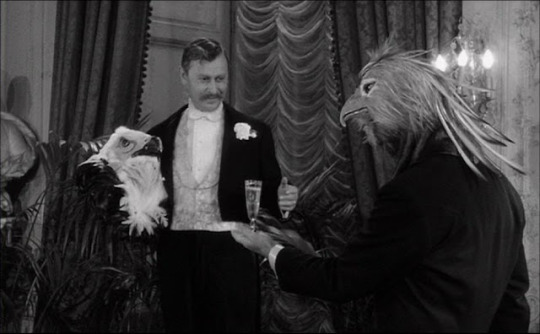
Michel Vitold and Channing Pollock in Judex (Georges Franju, 1963)
Cast: Channing Pollock, Francine Bergé, Edith Scob, Michel Vitold, Jacques Jouanneau, Théo Sarapo, Sylva Koscina. Screenplay: Jacques Champreux, Francis Lacassin, based on a screenplay by Arthur Bernède and Louis Feuillade. Cinematography: Marcel Fradetal. Art direction: Robert Giordani. Music: Maurice Jarre.
Judex is, like Steven Spielberg's Raiders of the Lost Ark (1981) and the subsequent Indiana Jones sequels, an hommage more than a spoof. In both cases, the filmmakers were affectionately mimicking films of their youth: the cliff-hanging serials that often accompanied feature films. Unlike Spielberg, director Georges Franju had a particular director in mind: Louis Feuillade, who crafted adventure thrillers usually involving master criminals like the titular protagonist of Fantômas (1913) and the sinister Irma Vep of Les Vampires (1915-16). The original Judex serial of 1916 featured a masked crime-fighter, a figure that became increasingly popular after Douglas Fairbanks adapted a magazine story in The Mark of Zorro (Fred Niblo, 1920), leading to numerous comic books and movies about swashbucklers and superheroes using disguises to protect their secret identity. The archetype became so prevalent that eventually it was subject to amused mockery, as in the camped-up Batman TV series of 1966-68. But Franju isn't out to mock Feuillade's serials so much as to recapture some of the innocent thrills of the original, with sets and costumes evoking a pre-World War I naïveté. Judex (Channing Pollock) is a do-gooder who in the film is trying to expose the fraud and murder committed by a wealthy banker, Favraux (Michel Vitol). He has somehow disguised himself (with an obvious fake beard) as Favraux's secretary, Vallières-- the film never bothers with backstories of its characters, so we don't know how Judex/Vallières gained Favraux's confidence and trust -- and manages to fake Favraux's death and hide him away in an elaborate dungeon, where he watches Favraux via an improbably early version of television. But Judex's plans -- which are not entirely clear in any case -- are complicated by his adversary, Diana Monti (Francine Bergé), who has herself been operating as the governess for Favraux's granddaughter. And so on, through an increasingly intricate series of plot twists, clashes, escapes, last-minute rescues, and all of the trappings of the genre. It's really a good deal of fun, though it occasionally goes a little slack, especially if you're not in the mood for such Gallic nostalgia. Marcel Fradetel's black-and-white cinematography mimics the silent-movie style to the mark, even using old-fashion iris shots for transition, and at one point having the comic-relief detective, Cocantin (Jacques Jouanneau), peer through the keyhole, with what he witnesses viewed through a keyhole-shaped aperture. Judex is played by an American magician, Channing Pollock, who performs some sleight-of-hand involving doves. A very handsome presence but no actor, Pollock was hyped as a new Rudolph Valentino, but without success.
1 note
·
View note
Note
What movie are those intertitles you just posted from?
fantômas (1913-1914) by louis feuillade
1 note
·
View note
Text

affiche de 1913 (gaumont) pour fantômas
22 notes
·
View notes
Text



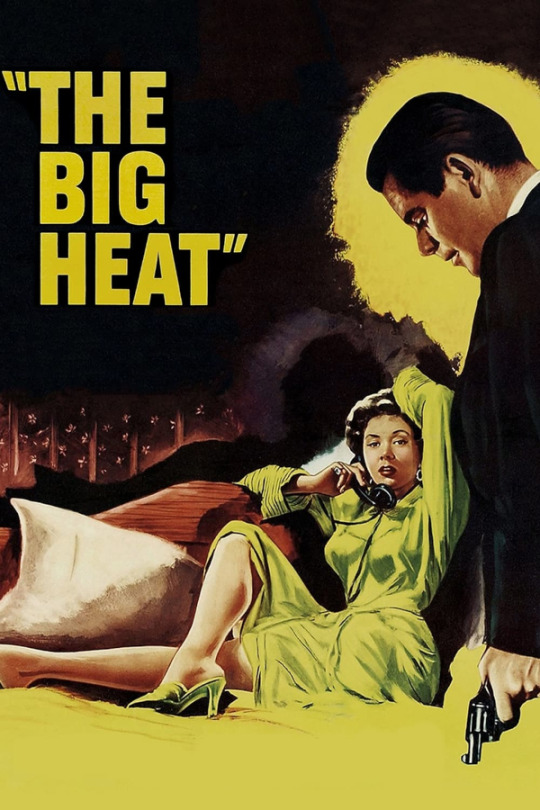





My Top 9 Favorite Films I Watched in 2023 (First Time)
Napoléon (1927) | dir. Abel Gance
Cat People (1942) | dir. Jacques Tourneur
Les Vampires (1915-16) | dir. Louis Feuillade
The Big Heat (1953) | dir. Fritz Lang
Fantômas (1913-14) | dir. Louis Feuillade
M (1931) | dir. Fritz Lang
Notorious (1946) | dir. Alfred Hitchcock
Asphalt (1929) | dir. Joe May
Mean Streets (1973) | dir. Martin Scorsese
*My Top 9 Favorites of 2022
#napoléon (1927)#cat people (1942)#les vampires (1915)#the big heat (1953)#fantômas (1913)#m (1931)#mean streets (1973)#asphalt (1929)#notorious (1946)#top nine favorites#top nine films#top nine movies#films watched in 2023#movies watched in 2023#film recommendations#my post
8 notes
·
View notes
Text


Fantomas: A la sombra de la guillotina / Fantômas - À l'ombre de la guillotine - Louis Feuillade [1913] 🇫🇷
#fantomas#alasombradelaguillotina#alombredelaguillotine#louisfeuillade#1913#france#francia#cine#movies#me#oroymierda#peliculas#films
9 notes
·
View notes
Note
How do you think French Fantômas and Mexican Fantômas would react if they discovered the existence of each other ?

It's a very amusing coincidence that the timelines for these two actually align almost exactly in where one ends and the other begins. Fantomas's original canon takes place around 1909-1913, but Allain wrote Fantomas stories all the way to 1963, and while I can't get my hands on those or even find them for purchase, he's presumably never bothered to explain the time that's passed. Then, circa 1964, we have the Jean Marais blue faced Fantomas from the parody film. And then, circa 1966, Novaro Editorial starts publishing Fantomas, adapting the original stories and sort of mixing the two Fantomas together. And interestingly, the stories actually do demonstrate this shift happening.
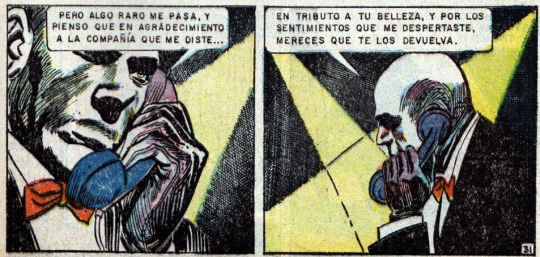
When Novaro started publishing Fantomas, they ran with the original version for about 9 stories. You can look at the image above and see that Fantomas was very much still intended to be the sinister villain, even if he started off much less horrible than in the novels since, by this point, the parody Fantomas from the film was still the main influence. And then we hit issue 10 in a story called Fantomas contra Fantomas, presumably based on the 1949 serial, and the story for the most part is like all the others. Lots of people talking, policemen fumbling around, Fantomas on a screen/phone talking to henchmen, and so forth. But there's something very different about this story, and it's Fantomas himself. You'd think that the transformation from novel/movie Fantomas to comic book would be some kind of gradual process, and that's what I assumed it was, until I read the comic.

And it's literally just two pages. In one page he's a sinister blue-faced being commanding orders to his henchmen, and the other, literally from one panel to the other, he goes from the blue-faced Bond villain from the film, to a quiet and contemplative man resting in an armchair playing around with his cat waiting for pieces to fall in place for his new game. And indeed, the whole story ends with Fantomas handing the fake Fantomas behind the current crimes to the police, with a final letter that is pretty out of character for the original Fantomas, but much more in line with the characterization he would take going forward. This story draws a very clear line in the sand: Out with the old and busted, in with the new hotness.
You wouldn't be that far off in assuming that Fantomas's redemption arc started simply because he got a cat.
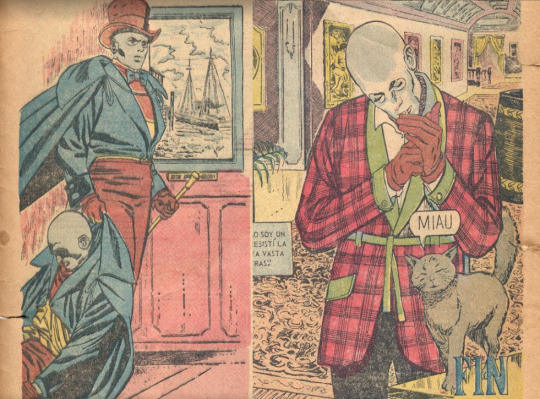
Dear journalists and Inspector Gerard: In front of you is the real thief of famous paintings. I was fine with him using my name, until he mistook a bad copy for an original.
I am a cultured man and a connoisseur of art: whoever cannot distinguish a true Cezanne is an idiot. He also did not commit the robberies because he was an art lover, but for money, and because he did not care that the paintings left France.
On the other hand, I make it known to you that the stolen Courbet has been returned into the hands of it's owner. I dislike making moves against poor people.
As for the other paintings that were stolen by the wretch that I left tied up, I must confess that, as I am in love with them, I could not resist the temptation to enrich my already vast collection of masterpieces.
The very next story, Fantomas steals a time machine to try and steal a ruby that once belonged to Genghis Khan, and after a bunch of adventures through time, he ends up failing. Two stories afterwards, Fantomas takes a look at the world, it's nukes and weapons race and the elites and politicians furthering it along, and states he's never had a bigger challenge than solving that, and decides to fight for world peace. So he assembles a league of the world's greatest scientists and fakes a message from aliens to all the world leaders telling them to dissassemble the arms race and instead divert all their resources to fight for the preservation and progress of the human race, and it actually works.
He tells the scientists that, although he is not considered a noble man, the magnitude of importance in this mission inspired him, later privately confiding to his cat that, actually, the real reason he sought to bring world peace was so war couldn't interfere with his plans. Fantomas pulled off Ozymandias's goal literal decades before Watchmen, and he did so without spilling a drop of blood. I mean, not that it lasted, obviously, but it was very clearly a different direction than what had been done with the character before, and this was going to be the direction going forward.

These stories are set in France, by the way, actually a lot of the Fantomas comics allude to the stories taking place in France. Sometimes they take place in France and sometimes they take place in some fake city and sometimes it's just Mexico, the latest stories seem to be pretty firmly set in Mexico, and the character's a globetrotter so he goes everywhere.
So really the question isn't how they react if they'd discovered each other, because you'd be hard pressed to find two characters less compatible and less willing to tolerate the other's existence. If these two exist in the same world, there is no way they don't know of each other at the very least.
How can French Fantomas possibly maintain a career and legacy as a mastermind of terror when this globally famous do-gooder keeps going around fighting crime and opression and acting as an ambassador for peace and goodwill and progress? How can the Mexican Fantomas possibly do good in the scale he must, or even get away with the odd mischief, if he bears the name and legacy of a globally infamous horror who drowned France in the blood of men, women, children and animals for years? What will the legacy of the name Fantomas be to the world?
It's a very clear Ultimate Evil vs Ultimate Good, past vs future conflict here, the old gothic serial killer vs the new sexy superhero, the two having very clearly defined worlds that are wholly incompatible, that you'd have to drag them outside of in order for this conflict to play out and risk undermining both characters.
The two things they have in common besides a name are the very clear storytelling precedents they share. One is, momentary disguises and diversions aside, there is only one Fantomas. And the other is the hardline rule of their universes: Fantomas Always Wins.

But how can Fantomas always be the sole victor, if he's not even the sole Fantomas?
Clearly one of them's gotta go.
Actually, I just discovered there WAS a Mexican Fantomas story detailing the two meeting. It was called “Uncle Fanto”, and it’s about an elderly Fantomas coming to visit his nephew, until he falls and busts a leg, and everyone laughs at him when he claims to be Fantomas, and Fantomas explains that his uncle misused his virtues for the sake of evil, and was incarcerated 20 years ago, and since then he’s been cleaning the name. Uncle Fanto’s looking for him because Allain has died and he has nothing left.


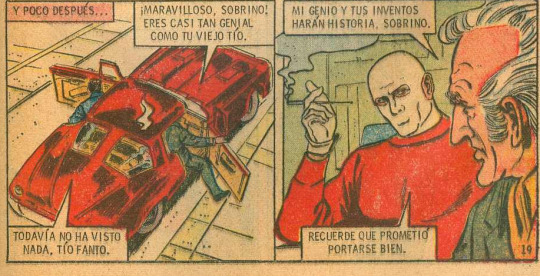
My genius and your inventions will make history, nephew
You recall that you promised to be on good behavior
And the story ends with Uncle Fanto getting stopped from an attempt to do one last crime, and promising that he won’t go back to the way he used to be, so Fantomas takes him to Professor Semo, who applies a memory-wiping treatment, fixes his knee and renews his agility (Semo is definitely my least favorite part of these stories because goddamn the guy is sketchy). The story ends with Uncle Fanto racing a robot.
Obviously this is a very “tame” take on this story and the original Fantomas, who’s presented here as mostly a robber and criminal mastermind (and he’s said to be sixty years old in 1971, which means he would have been born in 1911, so he definitely could not be the original Fantomas), and not the one I’d go with if I put these two together, but it’s the official one. It’s perfectly in line with the reocurring trend of the Mexican Fantomas finding ways to redeem villains and give them second chances.
Maybe he himself was a second chance for the original Fantomas.
29 notes
·
View notes
Photo

Louis Feuillade, February 19, 1873 – 25 February 25, 1925.
Fantômas (1913).
51 notes
·
View notes
Photo

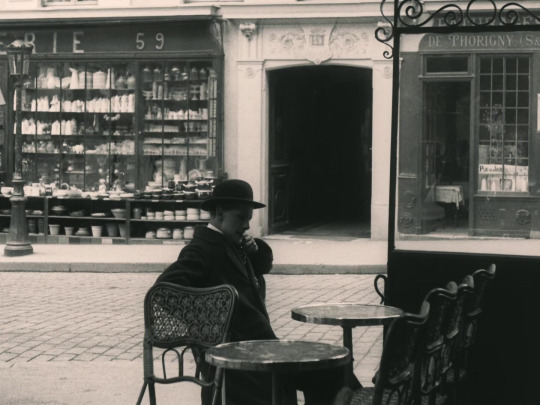





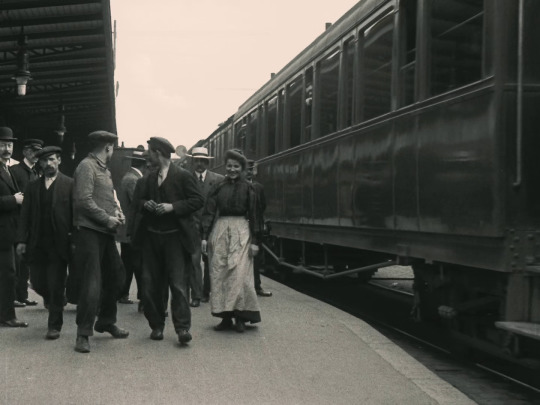


Fantômas II: Juve contre Fantômas (Louis Feuillade, 1913).
169 notes
·
View notes

